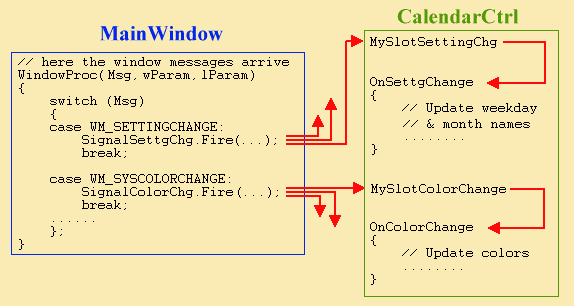Qt Signal Slot Call Order
- PyQt Tutorial
- PyQt Useful Resources
In contrast to slots, signals may be handled by none, one or many components. There is no guarantee that triggering a signal in C will actually run QML code, unless there’s a handler defined. Properties work both ways: Properties are read- and write-able from both C and QML. I have a doubt about the call order of slots. If I connect a single signal to more than one object/slot, the calls to the slot functions will follow the same order as they were connected? For example: QObject::connect ( this, SIGNAL(valueChanged(int)), object1, SLOT(slot1(int)) ). QtCore.QObject.connect(widget, QtCore.SIGNAL(‘signalname’), slotfunction) A more convenient way to call a slotfunction, when a signal is emitted by a widget is as follows − widget.signal.connect(slotfunction) Suppose if a function is to be called when a button is clicked. Here, the clicked signal is to be connected to a callable function.
A developer can choose to connect to a signal by creating a function (a 'slot') and calling the connect function to relate the signal to the slot. Qt's signals and slots mechanism does not require classes to have knowledge of each other, which makes it much easier to develop highly reusable classes. QPushButton emits signals if an event occurs. To handle the button connect its appropriate signal to a slot: connect(mbutton, &QPushButton::released, this, &MainWindow::handleButton); Example. The following simple code snippet shows how to create and use QPushButton. It has been tested on Qt Symbian Simulator. An instance of QPushButton is.
- Selected Reading
Unlike a console mode application, which is executed in a sequential manner, a GUI based application is event driven. Functions or methods are executed in response to user’s actions like clicking on a button, selecting an item from a collection or a mouse click etc., called events.
Widgets used to build the GUI interface act as the source of such events. Each PyQt widget, which is derived from QObject class, is designed to emit ‘signal’ in response to one or more events. The signal on its own does not perform any action. Instead, it is ‘connected’ to a ‘slot’. The slot can be any callable Python function.
In PyQt, connection between a signal and a slot can be achieved in different ways. Following are most commonly used techniques −
A more convenient way to call a slot_function, when a signal is emitted by a widget is as follows −
Suppose if a function is to be called when a button is clicked. Here, the clicked signal is to be connected to a callable function. It can be achieved in any of the following two techniques −
or


Example
In the following example, two QPushButton objects (b1 and b2) are added in QDialog window. We want to call functions b1_clicked() and b2_clicked() on clicking b1 and b2 respectively.
Qt Signal Slot Call Orders
When b1 is clicked, the clicked() signal is connected to b1_clicked() function
When b2 is clicked, the clicked() signal is connected to b2_clicked() function
Example
Qt Signal Slot Call Ordering
The above code produces the following output −